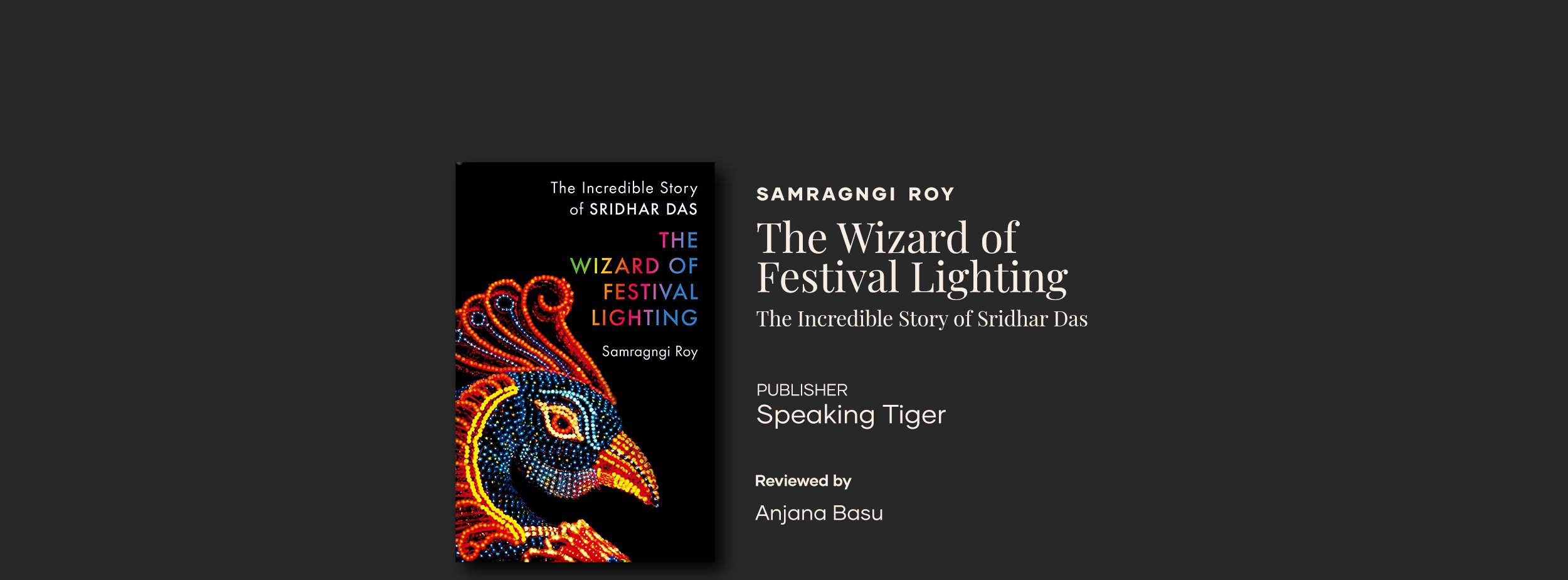
Twinkling lights, an elephant raising its trunk, monkeys climbing trees – all of Bengal is familiar with the light shows that surround Durga Puja and increasingly other events around the city. Gradually over time, too the lights have been associated with Chandannagar, where they come into their own during Jagaddhatri Puja and people have also become aware of festivals of Chandannagar lights in Bengal. However, what has stayed off the radar is the name of the man who created these illuminations, Sridhar Das. In this book, Samragngi Roy writes the very personal biography of her grandfather, the wizard of festival lighting.
Those familiar with Bengali soaps will find a pang of familiarity in the ups and downs of Sridhar Das’ life - struggles, cruel parents, bullies, forbidden love, rivals, and sabotage all the stuff that raises TRP though in this case grim reality. He came from a family of labourers – his father worked in a jute mill and his mother was always pregnant and always toiling. From the beginning, he was fascinated by electronics and lighting – the man who had an electric shop nearby was kind to him and Das picked up bits and pieces of experience with wiring. During Saraswati Puja in his school, he volunteered to do the lights and was mocked by his classmates and schoolmaster but owing to the Headmaster’s permission he was able to create his first ‘rolling’ lights and surprised everyone. However, he dropped out of school in Class Eight and continued with his self-taught experiments in lighting working with wiring and making some money by repairing lights for neighbours. One could say the theme was from zero to hero but the path was far from easy for Das.
Gradually his talent grew and he began to explore more and more ways of lighting for the puja committees that started to come to him. Roy describes his risky experiments with underwater lighting that actually only became risky when he grew overconfident. She also speaks of his failures when the committees failed to understand his vision. As his successes began to be known outside his hometown, Das attracted envy and occasionally sabotage from his rivals who had started following in his footsteps. Panels were destroyed at crucial moments, quotes were leaked to competitors by his own manager. In most cases he had no proof – bleaching powder was dropped on one of the main panels in a display by his own nephew who claimed that there were rats in the factory. Later he learned his nephew had been bribed and the boy then went off to work for a competitor thereby proving the suspicion.
Roy, writing against a background of her own depression frames the book in conversations between herself and her grandfather, grandmother, and mother. What comes through is a man obsessed with lighting and ways to make people stop and stare at sheer beauty. So obsessed in fact that family concerns often fell by the wayside - Das pawned his wife’s bangles to finance a project and apparently never replaced them. Nor did he buy his family new clothes for festivals – this despite the fact that he married for love and broke caste boundaries to tie the knot with a Brahmin when he himself was a lower caste Vaishya. The marriage caused disruption on both sides of the family with Das’ brothers maligning their future sister-in-law. When he had finances, Das looked after his wife’s family as far as he could and strived to build a better house for them all to live in. He also treated his workers so well during peak season with advances and special kitchens around the factory serving four meals that he had no dropouts. Ultimately his was a world in which his walls were hung with awards – but to achieve it he went through stress, blackouts, and warnings from doctors that pacemakers would not allow him to work with electricity and insulting graffiti splashed across the city walls. Regardless, Das forged on and never lost his positive energy.
Roy’s style is simple and the story flows without interruption holding the reader’s interest because of its very personal approach and the conversations. However, the fact that her grandmother tried a hand at light panels with her husband allowing it indulgently, is never really expanded on. Roy’s narrative throws light on the caste-ridden atmosphere in small towns and how even lower castes can turn on their own families if it suits them. It also highlights the difference between Das’ broad vision which adapted to all kinds of themes and the more narrow perspective of other lightmakers whose regional themes often did not gain them recognition outside Chandannagar.
Roy ends the book with the spectacular success of the Peacock boat that sailed down the Thames, possibly Das’ most outstanding project, and mentions his friendship with a British electrician, a wired relationship that transcended the boundaries of language.
Das has seen the heights of fame but also seen his achievements forgotten as other light artists jostled for attention in Chandannagar – he recognised the contribution of Asim Dey who was the first to introduce LEDs for festive panels and struck a blow for the environment, though LED lighting took time. Today too, many panels are brought back from the previous year to grace Puja pandals for purposes of eco-friendliness so the face of festival lightning may have different variations to throw up in a time of climate change, and, while Das is still around, possibly, new sparks of inspiration.
